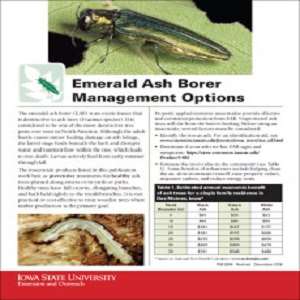Emerald ash borer continues to move into Iowa, with the Iowa Department of Agriculture and Land Stewardship announcing on Nov. 28, 2016, that the invasive beetle that attacks and kills all ash species has been confirmed in 39 counties.

emerald ash borer publication front pageWith the invasive beetle having been confirmed in nearly 40 percent of Iowa’s 99 counties, protecting valuable ash trees has become decisively important. Iowa State University Extension and Outreach specialists have released an updated version of the publication "Emerald Ash Borer Management Options" (PM 2084) to provide tips for preventive treatments for healthy ash trees.
A version of the publication written in Spanish is also available (PM 2084S).
“There have been new developments in emerald ash borer research so we wanted to update this publication to reflect that new information,” said Mark Shour, extension entomologist with Iowa State University. “The publication provides the correct time for EAB treatments, the correct products to use and any environmental precautions that should be considered before treatment. It gives recommendations to homeowners and professionals alike.”
The publication is written by Shour, Laura Jesse and Donald Lewis, extension entomologists; Jeff Iles, extension horticulturist; and Jesse Randall, extension forester, with Iowa State University.
Properly applied insecticides provide the best protection against the beetle.
“If you don’t use a preventive product you won’t have an ash tree that survives EAB, that’s the bottom line. Those that have used preventive insecticides still have their ash trees,” Shour said. “There is research being done right now to see if we will be able to spread out the frequency of treatments in the future.
“It is very important for homeowners to know that over-the-counter products against EAB must be applied early in the spring; if applied any later they will just be wasting money. Professional treatments by certified pesticide applicators, however, can be made throughout the growing season. No homeowner soil treatments should be made within 25 feet of flowering plants or vegetable gardens as a protection against harming pollinators.”
Finally, the publication directs readers on how to identify ash trees, determine if a tree shows signs of EAB and evaluate the tree’s health.
Source: iastate.edu